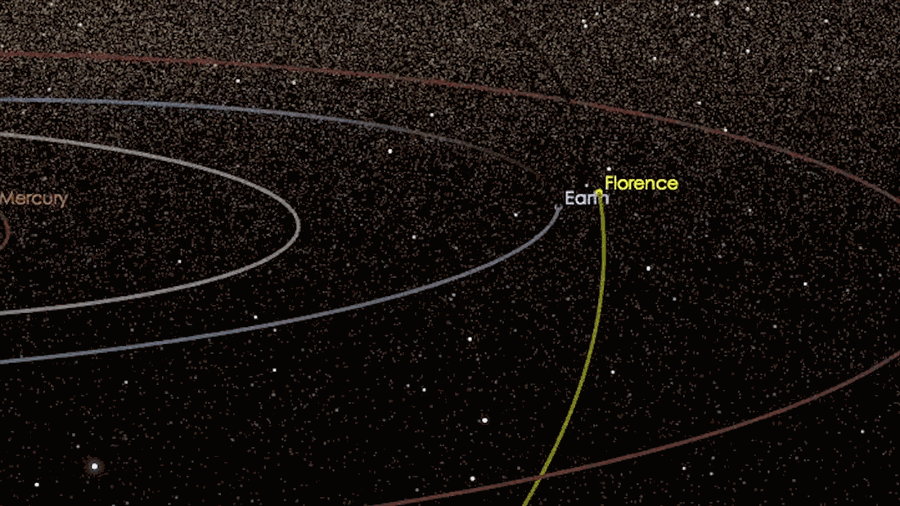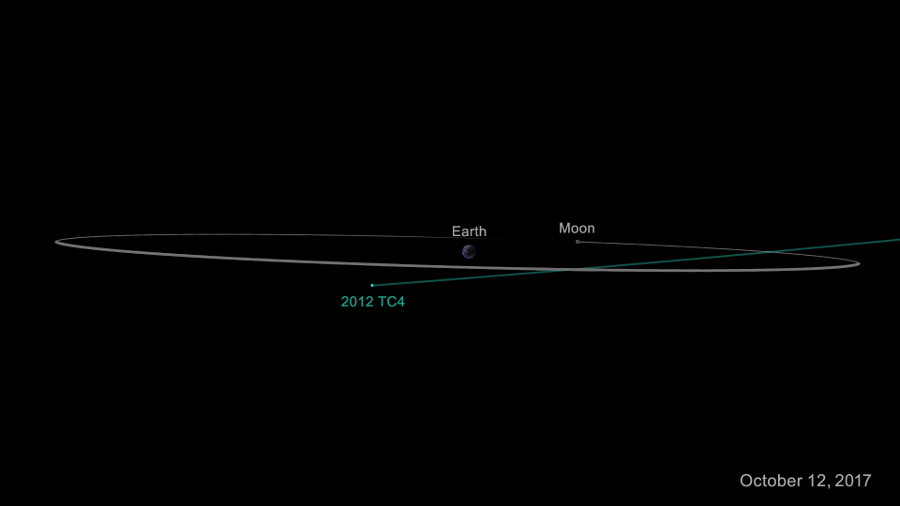A giant asteroid will pass nearby Earth on September 1, according to a statement from NASA. Scientists say it will be the closest approach ever by such a large asteroid.
The asteroid, named Florence, will safely fly past Earth at a distance of 4.4 million miles (7 million kilometers). And even though Florence is really big, the asteroid will bring no harm to our planet.

NASA said Florence is among the largest near-Earth asteroids that are several miles in size, as the asteroid is about 2.7 miles (4.4 kilometers) wide, according to measurements from NASA’s Spitzer Space Telescope and NEOWISE mission.
Asteroid Florence will approach Earth at 7 million kilometers on September
Scientists at NASA said that while other asteroids have fly past closer to Earth, none of those asteroids was as big as Florence.
“While many known asteroids have passed by closer to Earth than Florence will on September 1, all of those were estimated to be smaller,” Paul Chodas, manager of NASA’s Center for Near-Earth Object Studies (CNEOS) at the agency’s Jet Propulsion Laboratory in Pasadena, said in a statement. “Florence is the largest asteroid to pass by our planet this close since the NASA program to detect and track near-Earth asteroids began.”
The asteroid was named after Florence Nightingale, the “founder of modern nursing,” as cited by NASA. On September 1, scientists will seize the opportunity to study Florence up close. The asteroid is expected to be a good target for ground-based radar observations.

NASA scientists will monitor and track the path of the rock, which will come no closer than 4.4 million miles (7 million kilometers). The space agency’s statement also said radar imaging is planned at the National Science Foundation’s Arecibo Observatory in Puerto Rico and at NASA’s Goldstone Solar System Radar in California.
The resulting radar images will show scientists the real size of the rock and also could reveal “surface details as small as about 30 feet (10 meters),” said NASA.
Florence can be seen with any telescope because of its size
The asteroid was discovered by Schelte “Bobby” Bus at Siding Spring Observatory in Australia in 1981. According to scientists, the 2017 encounter is the closest by Florence since 1890 and the closest it will ever be until after 2050.
Florence is not the only rock that will approach Earth in the coming months. Another body, Asteroid 2012 TC4, will fly by Earth at 44,000 km on October 12.
Asteroid 2012 TC4 may be seen on October with the naked eye because of its proximity to our planet when it passes. On the other hand, anyone looking forward to seeing Florence can do so with a small telescope, despite the fact that the asteroid will be millions of kilometers away, it is so big that it will be visible. Plus, Florence will brighten to ninth magnitude.
“[Its] visible magnitude of 9 is really bright. Every amateur astronomer will be able to see it,” European Space Agency’s Near Earth Object segment co-manager Rüdiger Jehn said, according to Tech Times.
People eager to spot Florence with their telescopes should be able to find the asteroid somewhere along the constellations Piscis Austrinus, Aquarius, Capricornus, and Delphinus from around August 29 to September 8.
Asteroid 2012 TC4 will pass closer to Earth on October
Radar has been used to track hundreds of asteroids, said NASA. When asteroids –which are small, natural remnants of the formation of the solar system—fly past Earth at close ranges, deep space radar is a powerful method for studying their shapes, sizes, rotation, surface roughness and features, and an accurate determination of their orbital path.
The Jet Propulsion Laboratory manages and operates the agency’s Deep Space Network, including the Goldstone Solar System Radar. All of those gadgets and tools will be used to study everything they can about Florence for the several days it will be seen.

NASA scientists will also continue studying the behavior of asteroids in October, at the passing of 2012 TC4. While it’s estimated that the asteroid will approach Earth at 44,000 kilometers, scientists suggest that at its absolute closest, it could come as near as 6,800 kilometers (4,200 miles) from our planet.
Scientists at the Jet Propulsion Laboratory are also preparing for that event, and they’ve even coordinated with a network of observatories to observe 2012 TC4. The exercise will help astronomers preparing response time and communications for a future event in which an asteroid comes closer to Earth.
The project is led by Professor Vishnu Reddy from the University of Arizona’s Lunar and Planetary Laboratory in Tucson. Overall, more than a dozen observatories, laboratories, and universities will track down the asteroid 2012 TC4 in October.
Source: NASA
